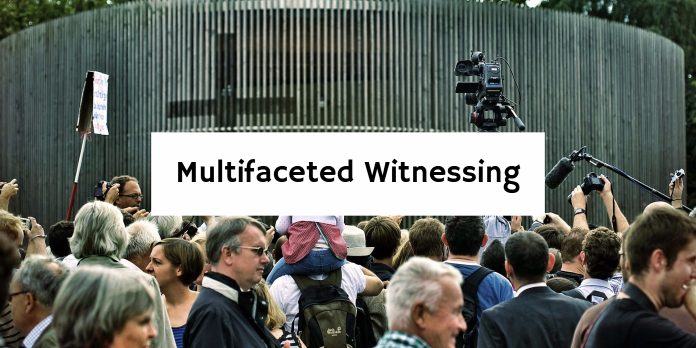In my recent blog posting on the “golf bag” image of atonement theory, I thought I was clearly defending the essential nature of substitution. But several readers somehow took me to be waffling, particularly because I allowed that in some cases we might look for a “hole in one” by presenting the defeating-the-Powers aspect to someone who is caught up in a fascination with, or in the grip of, evil spiritual forces.
Here is what I take to be a very important point. We should not assume that we have to present the whole theological picture all at once to unbelievers. People come to Christ for many reasons. This is not unlike human love relationships. Ask a person long married what first attracted them to the person who was to become their spouse. Most of us would be embarrassed to give the details. That does not make those initial attraction factors bad things. They are what bring people together. But once we are together, other factors need to take over if the relationship is to be sustainable for the long haul.
The same with coming to Christ. A very bright Fuller student—mature in the faith—once told me that he became a Christian through reading Hal Lindsey’s Late Great Planet Earth. He was fascinated with futuristic predictions, and Lindsey’s “Bible prophecy” offerings drew him into the study of the Scriptures. “A bit later on, I left all of that behind,” he testified, “but it was what the Lord used to bring me to Christ.”
So, I think any aspect of atonement theory is fair game in witnessing to others. But to come eventually to a more mature, biblically faithful understanding of what our salvation is all about is to recognize that God in Christ did for us what we could never do for ourselves—and because of what happened on the Cross, it can be forever more “well with my soul.”
Recognizing the multifaceted character of the gospel is, I am convinced, crucial for interfaith witnessing. A book that has influenced me much in this regard—I first read it as a young seminarian—is Bishop Stephen Neill’s Christian Faith and Other Faiths. In discussing a particular religion, Neill stresses the need to invite persons of that perspective to take an honest look at the Jesus of the New Testament. But his invitations have different Christological foci.
Devout Muslims, Neill says, have never really seen Jesus as he is presented in the Bible; they want to honor Jesus as a prophet, but their view of him is obscured by a “veil of misunderstanding and prejudice” because they insist that he basically failed in his prophetic mission. The Hindu, in turn, needs to look beyond the answers given to the basic spiritual questions posed within Hinduism, to see “the One in Whom those questions can receive their all-sufficient answer, the Lord Jesus Christ.” To the Buddhist, we must point to the Cross, where a peace is made possible that reaches beyond “[t]he Buddhist ideal of passionless benevolence.” Our message to animism can witness to the ongoing experience of connectedness in Christ’s Body, a community of people bound together by life in the Spirit of Christ. And to the existentialist (and this applies also to the advocates of the postmodernism that has emerged in the decades since Neill wrote his book), we can speak of the truly authentic existence that is made possible by the Risen Lord who has brought about the ultimate victory over death and despair, thus allowing us to live, by the power of the indwelling Spirit, in the hope of his final triumph.
To me, that kind of grasp of multifacetedness is not a denial of orthodoxy, it makes orthodox Christianity a rich mine of riches to draw upon.
4 Comments »
-
I’m a five-point Calvinist with a standard penal substitutionary view, and I thought your previous post was right on target. Indeed it reminds me of the “multiperspectival” approach of John Frame and Vern Poythress, and it dovetails with Frame’s approach to apologetics which emphasizes persuasion rather than absolute precision and rigor (e.g., one might use the cosmological argument to persuade, though it is ultimately circular since, as Gordon Clark says, “Aquinas [the argument’s formulator, drawing on Aristotle] has used for one of his premises the very proposition that he wants as the conclusion.”).
Comment by MF — August 5, 2010 @ 10:36 am
-
Related to the point about persuasion vs. perfection above, I a came across this quote, which follows some sharp criticism of purportedly flawed arguments, in N. T. Wright’s assessment of C. S. Lewis’s Mere Christianity: “Lewis himself would have been the first to say that of course his book was neither perfect nor complete, and that what mattered was that, if it brought people into the company, and under the influence (or ‘infection’) of Jesus Christ, Jesus himself would happily take over–indeed, that Jesus had been operating through the process all along, albeit through the imperfect medium of the apologist.”
It has some other interesting bits about not trying to say everything, particularly about the cross: “… Lewis’s treatment of the Cross [shows] Jesus as the ‘perfect penitent.’ Lewis is right to stress that Christians are not committed to one single way of understanding the meaning of the Cross, and that as long as one somehow looks at the death of Jesus and understands it in terms of God’s love and forgiveness, that is sufficient to start with” (emphasis mine).
Comment by MF — August 6, 2010 @ 1:37 pm
-
[For dessert I offer the following morsel that I recently ran into on the web! Lou]
Hal Lindsey’s Pretrib Rapture “Proof”
Is Hal Lindsey’s proof for a pretrib rapture “100 proof” – that is, 100 percent Biblical?
In “The Late Great Planet Earth” (p. 143) Lindsey gives his “chief reason” for pretrib: “If the Rapture took place at the same time as the second coming, there would be no mortals left who would be believers” – that is, no believers still alive who could enter the millennium and repopulate the earth.
We don’t know if Lindsey’s amnesia is voluntary or involuntary, or if he need amnesia rehab, but earlier (p. 54), while focusing on chapters 12 through 14 of Zechariah, Lindsey sees “a remnant of Jews in Jerusalem” who are mortals who will become believing mortals at the second coming and then become repopulating mortals!
During the same discussion of Zech. 12-14 Lindsey overlooks some of the final verses in Zech. 14. They reveal that some of the tribulation survivors “of all the nations which came against Jerusalem” will refuse to go there “to worship the King, the Lord of hosts.” Here’s what will happen to those “heathen” rebels: “upon them shall be no rain.”
So the facts about the repopulating mortals, in unbelieving as well as believing ranks, cancel out Lindsey’s “chief reason” for opposing a joint rapture/second coming – the ONLY rapture view to be found in official theology books and organized churches prior to 1830!
(See historian Dave MacPherson’s “The Rapture Plot,” the most accurate and most highly endorsed book on pretrib rapture history – available at online stores like Armageddon Books etc. Also Google “Scholars Weigh My Research” and “Pretrib Rapture Dishonesty.”)
Although Hal Lindsey claims that his “Late Great” didn’t set a date for Christ’s return, many of his followers – including copycats Bill Maupin (”1981″) and Edgar Whisenant (”1988″) – did view Lindsey as a date-setter, and his later book “The 1980s: Countdown to Armageddon” (the sort of title that date-setters and their ga-ga groupies love) became another fizzle – unless we’re still living in the 1980s!
In Old Testament days false prophets were stoned to death. Now they’re just stoned!Comment by Lou — August 8, 2010 @ 3:51 pm
-
Thank you for your insights on what’s the main connecting point between Jesus and Muslims, Hindus and Buddist. Very helpful.
Recently, I spoke with an orthodox, conservative Jewish man. What’s the key connecting point when talking about Yeshua to them?
Comment by Danita Bye — August 13, 2011 @ 7:01 am






























